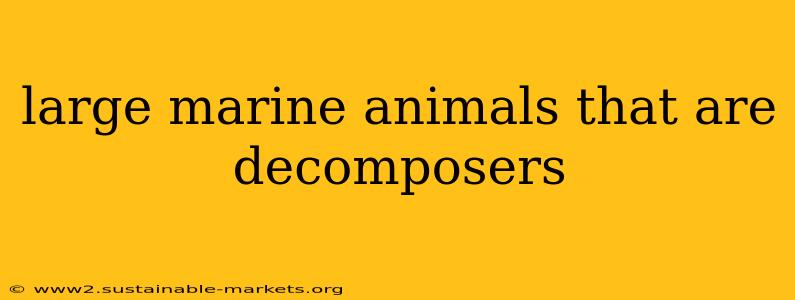The ocean, a vast and mysterious realm, is teeming with life, from microscopic plankton to colossal whales. While many marine animals are predators or herbivores, a crucial yet often overlooked group plays a vital role in maintaining the delicate balance of the ecosystem: the decomposers. While not exclusively large, several sizable marine animals contribute significantly to the decomposition process, recycling nutrients and keeping the ocean clean. This article explores these fascinating creatures and their critical ecological function.
Understanding the Role of Decomposers in the Marine Environment
Before diving into specific animals, it's essential to grasp the significance of decomposition in the marine environment. Decomposers, also known as detritivores, break down organic matter—dead plants, animals, and waste products—into simpler substances. This process releases vital nutrients back into the water column, fueling the growth of phytoplankton and other primary producers, forming the base of the marine food web. Without efficient decomposition, the ocean would be overwhelmed by decaying organic matter, disrupting the entire ecosystem.
Large Marine Animals Contributing to Decomposition
While bacteria and fungi are the primary decomposers in the ocean, several larger animals play a crucial supporting role. These animals aren't solely reliant on decomposition but actively participate in the process:
1. Sea Cucumbers (Holothuroidea): The Ocean's Vacuum Cleaners
Sea cucumbers, often found on the seabed, are a prime example of large marine decomposers. These echinoderms consume sediment, extracting organic matter and releasing nutrients back into the water. Their feeding habits contribute significantly to nutrient cycling and sediment turnover, making them essential players in maintaining the health of benthic (seafloor) ecosystems. Different sea cucumber species exhibit varying feeding strategies, some acting as deposit feeders (consuming sediment directly), while others are suspension feeders, filtering organic particles from the water column.
2. Certain Species of Crabs and Lobsters: Scavengers of the Deep
Many crab and lobster species are opportunistic scavengers, consuming decaying organic matter alongside their typical prey. These crustaceans play a significant role in cleaning up carcasses and other organic debris on the ocean floor, preventing the accumulation of waste and promoting nutrient recycling. Their size and abundance in various marine habitats contribute to their overall impact on the decomposition process. Larger species can tackle larger decaying organisms, accelerating decomposition.
3. Hagfish (Myxiniformes): Nature's Undertakers
Hagfish, often called "slime eels," are fascinating and often overlooked marine animals. They are primarily scavengers, feeding on decaying carcasses, often entering the body of a dead animal through its natural orifices or wounds. Their feeding habits contribute significantly to the breakdown of large organic matter, accelerating the decomposition process and releasing nutrients back into the environment. While not strictly decomposers in the same way as bacteria, their role in breaking down large carcasses is essential.
The Importance of Marine Decomposers: A Broader Perspective
The role of these large marine animals in decomposition extends far beyond simple waste removal. Their actions contribute to:
- Nutrient cycling: Releasing essential nutrients back into the ecosystem, supporting the growth of phytoplankton and other primary producers.
- Maintaining water quality: Preventing the buildup of decaying organic matter that could lead to oxygen depletion and other harmful environmental effects.
- Supporting biodiversity: Providing food and habitat for other organisms, contributing to the overall health and stability of the marine ecosystem.
Understanding the crucial role of these often-unseen decomposers highlights the interconnectedness of the marine food web and the importance of preserving biodiversity to maintain a healthy ocean ecosystem. Further research is needed to fully understand the contributions of these large marine animals to the decomposition process and their role in sustaining the delicate balance of ocean life.

